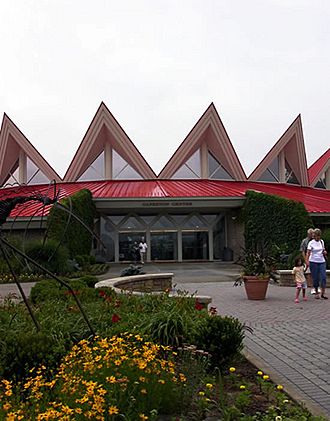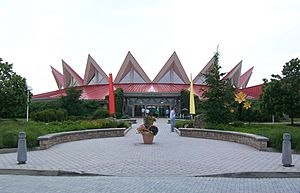Tamarack Marketplace facts for kids
Quick facts for kids Tamarack Marketplace |
|
|---|---|

Tamarack at the Beckley Service Area in Beckley, West Virginia.
|
|
| General information | |
| Architectural style | Postmodernism |
| Address | One Tamarack Park |
| Town or city | Beckley, West Virginia |
| Country | United States |
| Groundbreaking | August 8, 1994 |
| Completed | 1996 |
| Owner | West Virginia Parkways Authority |
| Design and construction | |
| Architect | Clint Bryan & Associates |
| Main contractor | Radford and Radford |
Tamarack Marketplace is a special place in Beckley, West Virginia. It is run by the West Virginia Parkways, Economic Development and Tourism Authority. Tamarack is known for selling unique items made by local artists. You can find things made from wood, glass, fabric, pottery, metal, and jewelry. They also sell food, art, books, and music.
Tamarack has five studios where artists work. You can often see them demonstrating their crafts. These demonstrations usually happen on weekends from spring to fall.
How Tamarack Started
Tamarack was first thought of in 1989. The governor at the time, Gaston Caperton, wanted to create a place to show off West Virginia's crafts. The state borrowed money to build it. This money was like a big loan, called a bond.
Planning for Tamarack began, and people looked all over the state for talented artists. An architecture firm from Charleston designed the building. Construction started on August 8, 1993. Tamarack officially opened in 1996.
Tamarack was special because it was the first place in the United States to bring together "handmade crafts, arts, and food" from an entire state. In 2003, a conference center was added to the building.
How Tamarack Helps West Virginia
Tamarack helps the state's economy in many ways. In 2007, a group called the Tamarack Foundation said the market made over $70 million each year. This money came from selling crafts and food. Tamarack also had 80 full-time employees.
In 2009, a study showed that Tamarack helped the state's economy by $18.6 million in 2008. It also supported 236 full-time jobs. Tamarack helped bring in more than $750,000 each year in state and local taxes. This does not even include the sales tax that goes back to the state.
In 2009, the money borrowed to build Tamarack was paid off. This helped reduce the costs of running the marketplace.
Looking at Tamarack's Costs
In 2007, a report looked at how much Tamarack cost to run. It showed that Tamarack had been costing the state money for several years. It cost the West Virginia Parkways Authority, which also runs the West Virginia Turnpike, about $2 million to $3 million each year.
Some people thought this report did not tell the whole story. They said Tamarack should not be judged only on how much money it makes from people stopping by. An artist at Tamarack said the report did not count sales to other businesses. It also did not count how Tamarack helps tourism. For example, it encourages people to visit places like Winterplace Ski Resort and New River Gorge National Park and Preserve. A business owner said Tamarack helps make West Virginia look good.
Greg Barr, who manages the West Virginia Parkways Authority, explained it this way:
"Tamarack is not just a business. That's where they're missing the mark. It's there to support and nurture the artisan industry [...]. It's a benefit that should not be solely determined by what the bottom line of that bricks and mortar facility is."
He meant that Tamarack's main goal is to help artists and the state's culture, not just to make a profit.


